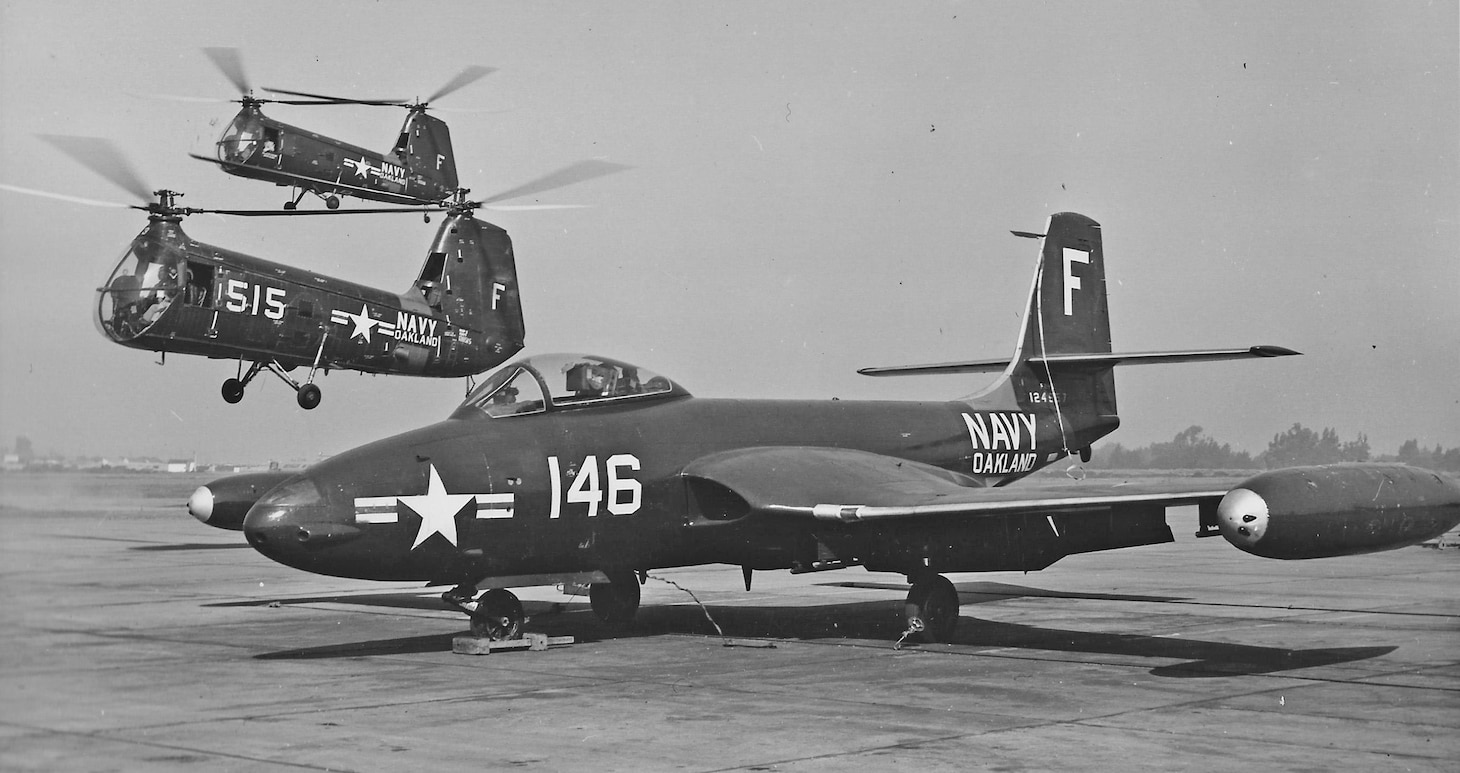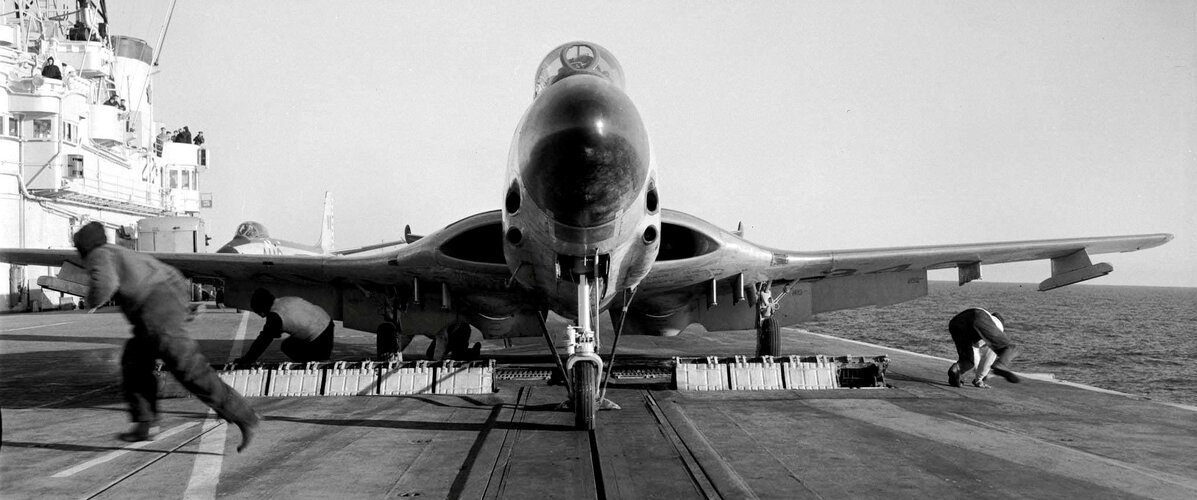- Yes
- No

This is a suggestion post for the F2H-4 Banshee, the final variant of the Banshee family. No previous suggestions have been made for this plane, except for its very similar earlier iteration, the F2H-3:
I. FH Phantom and F2H-2 Banshee
During the height of the Pacific War, while Grumman and Vaught pumped out aircraft by the thousands daily to fuel the war effort, McDonnell, a small and totally unknown design bureau by comparison, bid its time to design the jet-powered replacements of the piston-engined mainstays of the US Navy. This work would culminate in the FH Phantom, a modest and easygoing compact twin-engined fighter jet, which proved the viability of jet-powered carrier aviation. While not an imposing fighter on its own, it proved to be an important first step, leading to its successor, the bigger, and meaner, F2H Banshee. The jet proved a successful design, a flexible, long-ranged and hard hitting middle-weight fighter - until outclassed by the sudden appearance of the Soviet swept wing MiG-15 fighter.

II. The Bigger, Boxier Banshee
With the realization that straight-wing jet fighters were immediately outclassed by the MiG-15 and F-86 Sabre, aircraft designs had to be completely re-adapted or remade from scratch to keep up with the times. However, this process takes time, and while designs like the F3H Demon were on the drawing board, an interim solution had to be drawn up to give the carrier groups a fighting chance. McDonnell decided the best course of action would be to improve upon the F2H-2’s pre-existing strengths, such as its long range, high-altitude performance, and mission flexibility, and incorporate features from the successful trial of the experimental, radar-equipped F2H-2N. Combined, this resulted in the bigger, boxy F2H-3 and F2H-4.

III. The F2H-4 Banshee
The F2H-3 proved to be the best short-term package for the mission of all-weather carrier defender and strike fighter, combining stable and agile straight-wing flight performance, high-altitude capability, a search and track radar (AN/APQ-41) substantially superior to the old APS-19 set used on the F2H-2N, and a bigger, more robust airframe capable of carrying more weapons, and better weapons at that. The F2H-3 would serve both the US Navy, as well as successfully be exported to the Royal Canadian Navy. Marginal improvements to the success of the F2H-3 led to its final iteration, the F2H-4. The F2H-4 would come equipped with the further improved AN/APG-37 radar, which would later be seen on the Sabredogs, and the most powerful pair of engines on the Banshee. In all, the F2H-4 would serve the US Navy and Marine Corps from 1953, after the Korean War, until its retirement in 1961, as the final straight-wing fighter jet. In 1962, the type, now in storage, would be redesignated F-2D.

IV. F2H-4 Banshee Statistics
F2H-4 stats will be put up next to the F2H-2’s stats for comparison
| F2H-2 | F2H-4 | |
|---|---|---|
| Length | 40’ 2" | 48’ 2" |
| Wingspan | 41’ 9" | 41’ 9" |
| Height | 14’ 6" | 14’ 6" |
| Empty Weight | 11,146 lbs | 13,183 lbs |
| Gross Weight | 20,555 lbs | 28,500 lbs |
| Engines (×2) | J-34-WE-34 | J-34-WE-38 |
| Total Thrust | 6,500 lbf | 7,200 lbf |
| Top Speed | 575 mph | 610 mph |
| Service Ceiling | 48,500 ft | 56,000 ft |
| Max. Range | 1,475 mi | 1,716 mi |
| Radar | AN/APG-30 | AN/APG-37 |
| Radar Type | Rangefinder | Search/Track |
| Tip Tanks | 200 gal (×2) | 170 gal (×2) |
| Bomb Capacity | 1,000 lbs | 2,000 lbs |
| Rockets | ×8 HVAR | ×8 HVAR |
| Cannons | ×4 M3 20 mm | ×4 Mk.12 20 mm |
| Ammo Pool | 600 rounds | 940 rounds ᵃ |
| Missiles | N/A | ×2 AIM-9B ᵇ |
a) 250 rpg were carried on the lower pair of cannons, while 220 rpg were carried on the upper pair of cannons.
b) AIM-9B’s were tested on the F2H-3 and -4 by the USN, which retained the wiring and wingtip pylons for it as in the picture above. However, only the RCN routinely operated F2H-3’s loaded with AIM-9B’s for missions
USN also operated the AIM-9B on their F2H-3/-4:

- Yes
- No
V. F2H-4’s place in War Thunder
The F2H-4 would be positioned at Rank V, of the tech tree, foldered underneath its predecessor, the F2H-2, on the US naval aviation line. Its battle rating would most likely be 7.7, or 8.0, depending on if its given a pair of AIM-9B Sidewinders. The addition of the missiles would make the F2H-4 the only tech tree equivalent to the uncommon premium Sea Hawk Mk.100, as Rank V straight-wing jets with early missiles. Without the missiles, the uprated jet engines, more powerful radar and improved cannons still justify a slightly higher BR of 7.7 versus the F2H-2’s 7.3.
VI. Citations




